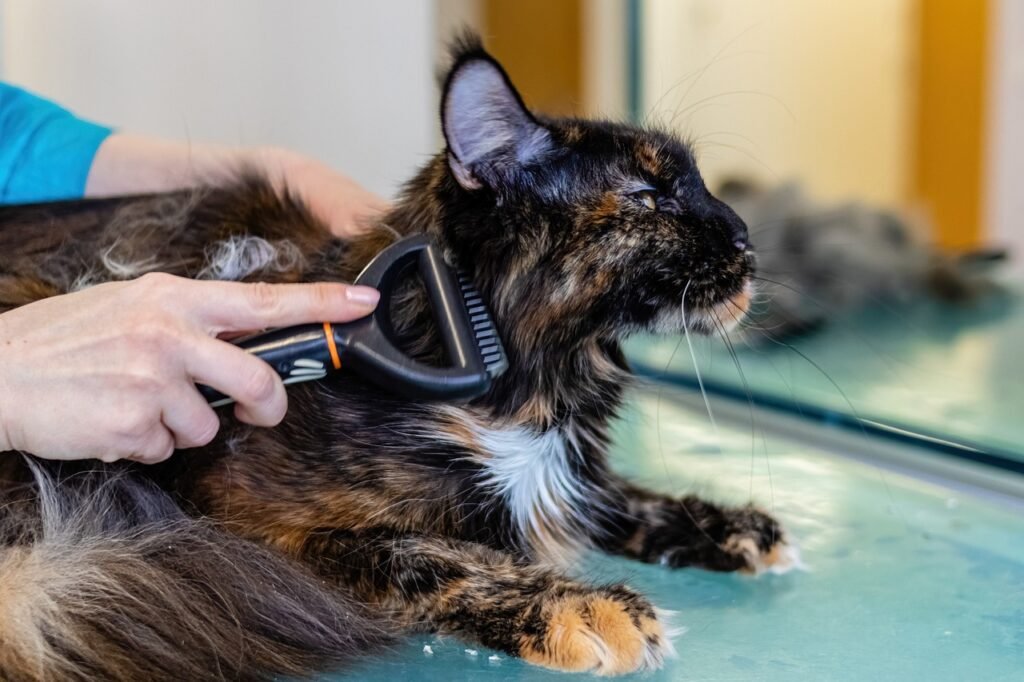
Matted fur in cats is a common issue faced by many pet owners, often due to negligence, improper grooming, or certain health conditions. While cats are generally good at grooming themselves, they sometimes need a helping hand. This article aims to provide an in-depth guide on mastering the management of matted fur, ensuring your feline friend remains comfortable and well-groomed.
Understanding Matted Fur
Before diving into the solutions, it’s essential to understand what matted fur is and why it occurs. Mats are clumps of tangled fur that can form anywhere on a cat’s body, but are more common in areas where there’s friction, such as behind the ears, under the legs, and around the neck.
Causes of Matted Fur
- Neglect: Regular brushing is crucial, especially for long-haired breeds. Lack of grooming can lead to tangles and mats.
- Health Issues: Conditions such as obesity, arthritis, or dental problems can make self-grooming difficult for cats.
- Shedding: Cats shed their undercoats seasonally, and this fur can get trapped in the top coat, leading to mats.
- Moisture: Wet fur can easily tangle, especially if not combed out immediately.
Preventing Matted Fur
Prevention is always better than cure. Regular grooming is the key to preventing mats from forming in the first place.
Regular Brushing
Brush your cat regularly, at least once a week for short-haired breeds and daily for long-haired breeds. Use the right tools, such as a slicker brush or a wide-toothed comb, to help remove loose fur and prevent tangles.
Bathing
While not all cats enjoy baths, occasional bathing can help keep their fur clean and free of debris. Use a cat-specific shampoo and ensure you thoroughly dry and brush your cat afterward to prevent tangles.
Healthy Diet
A healthy diet contributes to a healthy coat. Ensure your cat receives a balanced diet rich in omega-3 and omega-6 fatty acids, which promote healthy skin and fur.
Dealing with Matted Fur
If your cat’s fur is already matted, it’s important to address the issue promptly and carefully to avoid causing discomfort or injury to your pet.
Step-by-Step Dematting Process
- Assess the Situation: Gently feel the matted areas to determine the extent of the tangles.
- Gather Tools: You’ll need a dematting comb, a pair of scissors with rounded tips, and a detangling spray.
- Calm Your Cat: Before starting, ensure your cat is relaxed. You might need to take breaks or have someone help hold the cat gently.
- Apply Detangling Spray: Use a cat-friendly detangling spray to soften the mats, making them easier to work through.
- Work Gently: Start from the edges of the mat and work inward. Use a dematting comb to gently tease apart the tangles.
- Use Scissors with Caution: If a mat is too tight or large to comb out, use scissors to carefully snip it out. Never cut too close to the skin and always use scissors with rounded tips to prevent injury.
When to Seek Professional Help
If mats are too severe or your cat becomes stressed or aggressive, it’s best to seek help from a professional groomer or veterinarian. They have the expertise and equipment to safely remove stubborn mats without harming your cat.
Post-Dematting Care
Once the mats are removed, continue regular grooming to prevent future issues. Monitor your cat for any signs of skin irritation or discomfort following the dematting process.
Skin Inspection
Examine the skin under the mats for any signs of infection or irritation. If you notice any redness, bumps, or cuts, consult your veterinarian for advice on treatment.
Establish a Grooming Routine
Establish a consistent grooming routine tailored to your cat’s specific needs. Regularly check for new mats and tangles, especially in areas prone to matting.
Conclusion
Mastering the art of managing matted fur involves understanding the causes, implementing preventive measures, and knowing how to safely remove existing mats. Regular grooming, a healthy diet, and prompt attention to tangles can keep your cat’s coat healthy and free of mats. By following these tips, you can ensure your feline companion remains comfortable, happy, and stylish.
Additional Resources
For more information on cat grooming, consider consulting professional grooming guides, joining online forums for cat owners, or seeking advice from your veterinarian.
#ChatGPT assisted in the creation of this article.






